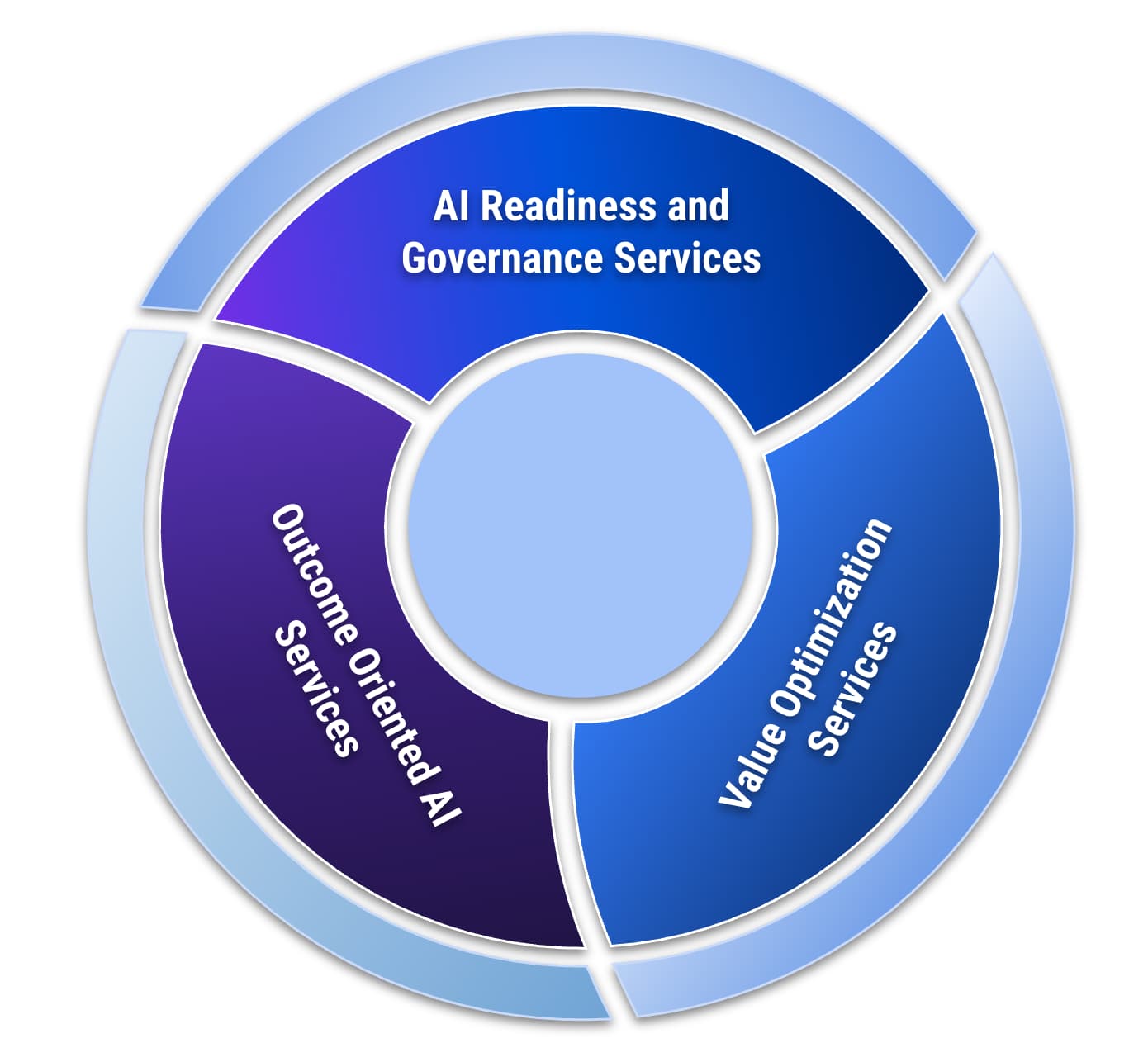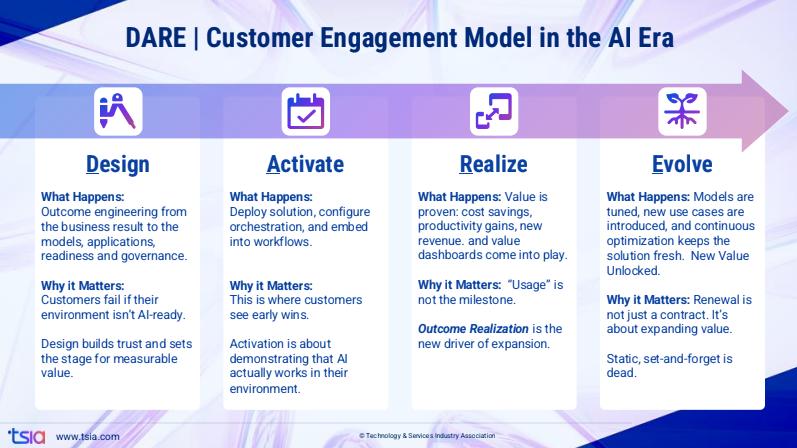AI isn’t the end of technology services—it’s the new foundation of profitability. In the era of AI Economics™, the winners won’t be defined by who builds the most innovative models or ships the most features. They’ll be the companies that master the economics of outcomes—engineering, monetizing, and guaranteeing measurable business results for their customers.
This is the Era of Services. The AI race is no longer about innovation for its own sake; it’s about who can operationalize AI into recurring value. If you lead product or service offers, your advantage lies in building the service capabilities that make AI profitable—before your competitors do.
Key Takeaways
- Serviceless AI is a myth. AI shifts accountability for business outcomes back to you, the vendor.
- Old pricing models break as automation erodes per-seat revenue—value and outcomes are the new anchors.
- Incumbents can win the AI race, but only if you retool your services portfolio now.
The Services Imperative: Completing the Sentence
There’s a half-truth circulating in boardrooms: “AI can take half the labor out of service organizations.” But the real story—the one defining AI Economics™—is what comes next. Reducing labor and cost isn’t the goal; it’s the catalyst.
The companies that will dominate the AI era are those that take the efficiency gains from automation and reinvest them in building new, high-value service capabilities—ones that enable AI to deliver tangible, profitable outcomes.
The future of technology profitability isn’t about cutting costs. It’s about reallocating resources to the services that will allow your AI products to succeed in the market.
This shift defines the Great Migration of Tech Services. AI and robotics transfer responsibility for outcomes from customers to you. When your product makes autonomous decisions, you own the results—and that requires a new portfolio of services built for accountability and scale.
Three New Categories of High-Value Services
- AI Readiness & Governance Services (ARGS): Help customers modernize data, align governance, and prepare for responsible AI deployment.
- Value Optimization Services (VOS): Deliver continuous value by actively monitoring and improving performance.
- Outcome-Oriented AI Services (OOAS): Operate AI in production tied directly to measurable outcomes and value-based contracts.
This isn’t theory—it’s your future operating model. Your services teams must evolve from supporting technology to engineering and guaranteeing outcomes.

Related: The AI Services Era: Why Services Are Now Your Greatest Advantage
The Competitive Axis: Your Advantage Is Earned, Not Given
AI competition is a two-horse race: incumbents versus AI-native disruptors. The good news? Incumbents hold the advantage—if you act.
You already have what startups don’t: deep domain expertise, trusted relationships, and global scale. Enterprise customers would rather wait for you to deliver AI-augmented value than risk operational disruption from an unproven vendor.
But that trust is perishable. If you don’t build the AI-driven service capabilities your customers expect, someone else will. Your goal now is to monetize customer business outcomes, not technology products or consulting hours. The companies that master this pivot will dominate the AI economy.
What Leading Companies Are Doing Now
Infor: The Power of the Micro-Vertical Mindset
Infor’s Mari Cross explained why horizontal platforms are a dead end. Infor embedded over 2,000 industry-specific processes directly into its software—such as dairy yield optimization—so implementations begin 80% complete.
The lesson: Value mapping is the new blueprint. Tie customer KPIs to embedded functionality and stop tracking vanity metrics like logins. Measure what the boardroom values—throughput, uptime, yield. When a 1% yield improvement saves half a billion dollars, you’re no longer selling software; you’re selling success.
SciLogic: Using Maturity Models to Align and Monetize
SciLogic’s Wendy Wooley showed how maturity models become your internal and external compass. Their five-phase model creates a shared language across product, marketing, and sales—and prevents misalignment.
AI without context is meaningless. SciLogic ensures every AI initiative maps back to a defined customer experience and measurable outcome. That structure enables monetization through acceleration, such as selling “AI Acceleration Packages” tailored to each customer's maturity stage.
Compugen: Standardization as a Profit Multiplier
Steve Spence from Compugen made it clear: operational chaos kills profitability. By linking offering management directly to managed services operations, Compugen standardized 80% of its design and sales motions.
Their “business catalog” now spans hardware, software, and services—a playbook that slashed proposal time by 36% and onboarding time by 50%. The takeaway? What starts well goes well. Standardization is the foundation for scalable, profitable AI services.
Related: Why Advanced Services Are Defining the Next Era of AI
TSIA’s Playbook for AI Economics™
If AI is transforming your P&L faster than your processes, you’re not alone. TSIA research shows that 95% of generative AI pilots fail due to flawed enterprise integration and adoption. The answer lies in re-engineering your offer life cycle, establishing a value engineering discipline, and climbing the pricing maturity ladder.
1. Re-Engineer the Offer Life Cycle
Stop defining success by consumption or usage. Redefine it around business outcomes you can prove.
The DARE Model provides the roadmap:
- Design: Engineer offers around readiness and outcome assurance.
- Activate: Deploy quickly to demonstrate early wins.
- Realize: Use dashboards to demonstrate measurable outcomes, such as cost savings or revenue lift.
- Evolve: Continuously optimize for sustained performance.

Adopt a Value Assurance Loop that tracks and demonstrates impact across every life cycle stage—from the pre-sales promise to the renewal proof.
2. Establish the Value Engineering Function
You can’t mature value delivery without structure. That’s where the Value Engineering Office comes in.
Organize teams around outcomes, not silos. Use Service PODs for vertical solutions (blending offer leaders, professional services, education services, customer success, and managed services teams) and Centers of Excellence for shared capabilities such as analytics and AI/DevOps.
This design allows your teams to define, deliver, and prove value—efficiently and repeatably.
3. Lead a Pricing-Led Transformation
Value-based pricing isn’t optional. It’s the survival mechanism.
When you shift your pricing model, you reshape your entire financial and operational structure. Move up the offer pricing continuum from traditional to consumption-based to outcome-based pricing.
Companies like Palantir are already proving the point: their profitability doesn’t come from software—it comes from outcome offers backed by services.
Related: Pricing-Led Transformation Under AI Economics™
What To Do Next
AI Economics™️ rewards the companies willing to rebuild, not just react. The path to profitability starts with deliberate reinvestment:
- Automate to accelerate: Identify which service motions AI can handle, and redirect those savings into higher-value capabilities.
- Engineer measurable value: Build a value engineering function that designs and monetizes the next generation of outcome-based services.
- Redefine your operating model: Structure teams around delivering results, not maintaining legacy roles or processes.
The companies that thrive in the AI era will be those that stop defending the old and start constructing the new. The economics of AI are already in motion—and profitability will favor the bold.
FAQs
What is AI Economics™?
AI Economics™ defines how AI changes the relationship between cost, value, and profit in technology services. It’s about designing offers in which services—not just software—create measurable, recurring value.
Why does value-based pricing matter?
Because AI automates traditional labor, per-seat or consumption pricing can’t sustain margins. Value-based models let you price and contract around the value you actually deliver.
How can I start retooling my services portfolio?
Begin by auditing where your service spend goes today, identifying what AI can automate, and reinvesting those savings into readiness, optimization, and outcome-oriented services that align with customer business results.
Smart Tip: Embrace Data-Driven Decision Making
Making smart, informed decisions is more crucial than ever. Leveraging TSIA’s in-depth insights and data-driven frameworks can help you navigate industry shifts confidently. Remember, in a world driven by artificial intelligence and digital transformation, the key to sustained success lies in making strategic decisions informed by reliable data, ensuring your role as a leader in your industry.





.png)








